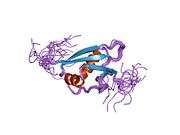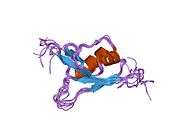UFM1
Ubiquitin-fold modifier 1, also known as UFM1, is a protein which in humans is encoded by the UFM1 gene.[3][4]
UFM1 is a ubiquitin-like protein that is conjugated to target proteins by E1-like activating enzyme UBA5 (UBE1DC1) and E2-like conjugating enzyme UFC1 (see UBE2M).[4]
Function
UFM1 shares several common properties with ubiquitin (Ub) and other ubiquitin-like molecules (UBLs). Ufm1 has similar tertiary structure to Ub but lacks any obvious sequence similarity. It is synthesized as an inactive precursor form (pro-Ufm1) which has 2 additional amino acids beyond the conserved glycine. The mechanism of Ufm1 conjugation is similar to that of ubiquitin. Mature Ufm1 has an exposed C-terminal glycine which is essential for subsequent activation by its cognate E1 protein (Uba5). This activation step results in the formation of a high-energy thiolester bond in the presence of ATP. The Ufm1 is subsequently transferred to its cognate E2-like enzyme (Ufc1) via a similar thioester linkage with a cysteine at the E2 active site. Ufm1 is conjugated to a variety of target proteins and forms complexes with as yet unidentified proteins. Thus, presumably there exist E3 ligases (none have been identified to date) to perform the final step in Ufm1 conjugation to relevant targets. The modification of proteins with Ufm1 is also reversible. Two novel cysteine proteases have been identified to date (UFSP1 and UFSP2) which cleave Ufm1-peptide C-terminal fusions and also removes Ufm1 from native intracellular conjugates. These proteases have no obvious homology to ubiquitin deconjugating enzymes. The proteins for Ufm1 conjugation (Uba5, Ufc1 and Ufm1) are all conserved in animals and plants (but not yeast) suggesting important roles in multicellular organisms. The exact role of Ufm1 modification in vivo is not yet known.[5]
References
- ↑ "Human PubMed Reference:".
- ↑ "Mouse PubMed Reference:".
- ↑ "Entrez Gene: UFM1 ubiquitin-fold modifier 1".
- 1 2 Komatsu M, Chiba T, Tatsumi K, Iemura S, Tanida I, Okazaki N, Ueno T, Kominami E, Natsume T, Tanaka K (May 2004). "A novel protein-conjugating system for Ufm1, a ubiquitin-fold modifier". EMBO J. 23 (9): 1977–86. doi:10.1038/sj.emboj.7600205. PMC 404325
 . PMID 15071506.
. PMID 15071506. - ↑ "Boston Biochem UFM1 overview". Archived from the original on October 15, 2007. Retrieved 2008-05-21.
Further reading
- Zhang QH, Ye M, Wu XY, et al. (2001). "Cloning and Functional Analysis of cDNAs with Open Reading Frames for 300 Previously Undefined Genes Expressed in CD34+ Hematopoietic Stem/Progenitor Cells". Genome Res. 10 (10): 1546–60. doi:10.1101/gr.140200. PMC 310934
 . PMID 11042152.
. PMID 11042152.
- Yu Y, Zhang C, Zhou G, et al. (2001). "Gene Expression Profiling in Human Fetal Liver and Identification of Tissue- and Developmental-Stage-Specific Genes through Compiled Expression Profiles and Efficient Cloning of Full-Length cDNAs". Genome Res. 11 (8): 1392–403. doi:10.1101/gr.175501. PMC 311073
 . PMID 11483580.
. PMID 11483580.
- Strausberg RL, Feingold EA, Grouse LH, et al. (2003). "Generation and initial analysis of more than 15,000 full-length human and mouse cDNA sequences". Proc. Natl. Acad. Sci. U.S.A. 99 (26): 16899–903. doi:10.1073/pnas.242603899. PMC 139241
 . PMID 12477932.
. PMID 12477932.
- Ota T, Suzuki Y, Nishikawa T, et al. (2004). "Complete sequencing and characterization of 21,243 full-length human cDNAs". Nat. Genet. 36 (1): 40–5. doi:10.1038/ng1285. PMID 14702039.
- Dunham A, Matthews LH, Burton J, et al. (2004). "The DNA sequence and analysis of human chromosome 13". Nature. 428 (6982): 522–8. doi:10.1038/nature02379. PMC 2665288
 . PMID 15057823.
. PMID 15057823.
- Komatsu M, Chiba T, Tatsumi K, et al. (2005). "A novel protein-conjugating system for Ufm1, a ubiquitin-fold modifier". EMBO J. 23 (9): 1977–86. doi:10.1038/sj.emboj.7600205. PMC 404325
 . PMID 15071506.
. PMID 15071506.
- Gerhard DS, Wagner L, Feingold EA, et al. (2004). "The Status, Quality, and Expansion of the NIH Full-Length cDNA Project: The Mammalian Gene Collection (MGC)". Genome Res. 14 (10B): 2121–7. doi:10.1101/gr.2596504. PMC 528928
 . PMID 15489334.
. PMID 15489334.
- Sasakawa H, Sakata E, Yamaguchi Y, et al. (2006). "Solution structure and dynamics of Ufm1, a ubiquitin-fold modifier 1". Biochem. Biophys. Res. Commun. 343 (1): 21–6. doi:10.1016/j.bbrc.2006.02.107. PMID 16527251.
- Ewing RM, Chu P, Elisma F, et al. (2007). "Large-scale mapping of human protein–protein interactions by mass spectrometry". Mol. Syst. Biol. 3 (1): 89. doi:10.1038/msb4100134. PMC 1847948
 . PMID 17353931.
. PMID 17353931.
PDB gallery |
|---|
|
| 1j0g: Solution Structure of Mouse Hypothetical 9.1 kDa Protein, A Ubiquitin-like Fold |
| 1l7y: Solution NMR Structure of C. elegans Protein ZK652.3. NORTHEAST STRUCTURAL GENOMICS CONSORTIUM TARGET WR41. |
| 1wxs: Solution Structure of Ufm1, a ubiquitin-fold modifier |
|
|

 . PMID 15071506.
. PMID 15071506. . PMID 11042152.
. PMID 11042152. . PMID 11483580.
. PMID 11483580. . PMID 12477932.
. PMID 12477932. . PMID 15057823.
. PMID 15057823. . PMID 15071506.
. PMID 15071506. . PMID 15489334.
. PMID 15489334. . PMID 17353931.
. PMID 17353931.

